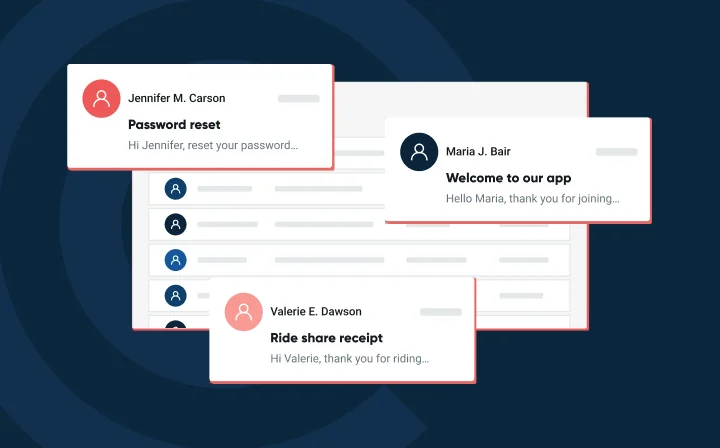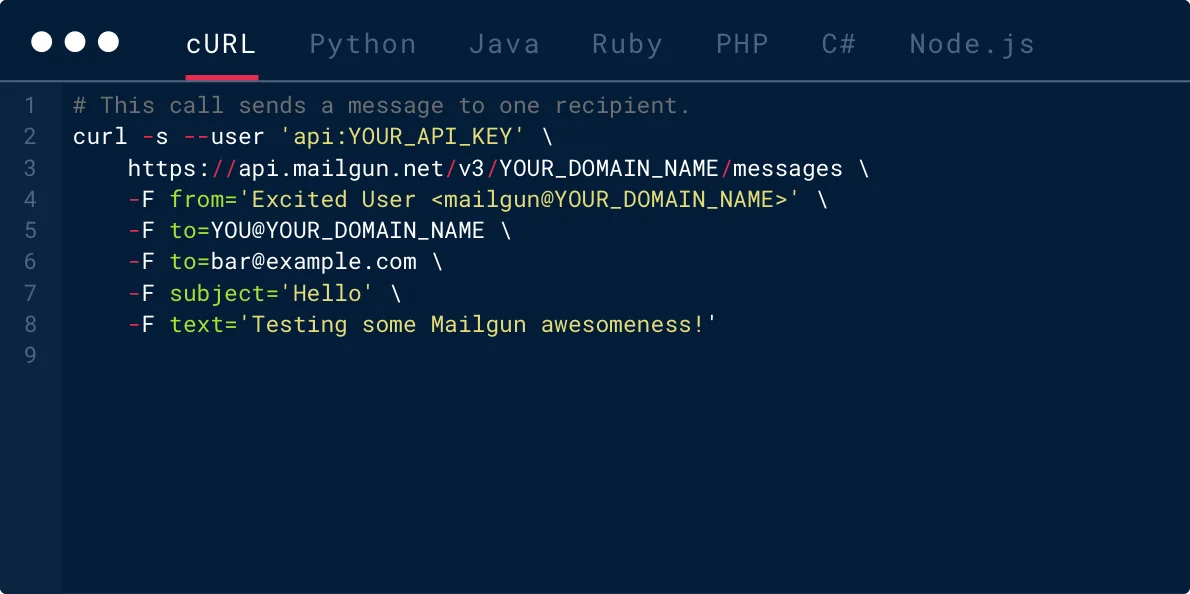SMTP v. API: Their differences and how to use them


You’re tasked with integrating email into the app you’re building or the customer relationship management (CRM) tool your business uses. You have two options: traditional SMTP or an SMTP API, which uses HTTP requests (often RESTful and JSON formatted) for faster and more flexible email sending and management. Both are crucial to your email development and deployment process, whether you’re sending an email marketing campaign or a triggered transactional email. But what are they, and when do you use each?
We’re diving right in and tackling SMTP first. What is it, and how do you use it?
SMTP stands for Simple Mail Transfer Protocol, and it’s the method of sending emails across the internet. An SMTP server lets you use SMTP to transfer mail through a server and across a network to its destination. Unlike most computer servers that handle multiple processes at any given time, an SMTP server is only used to send, receive, and transfer email. Mailgun acts as an intermediary to send mail via SMTP, as shown below:

SMTP is designed specifically for one job – sending emails. It handles the transfer of messages from the sender’s server to the recipient’s server, ensuring reliable delivery.
When sending via SMTP, you may wonder which SMTP port to choose. Port 587 is considered the default SMTP port for mail transfer. You should use it, unless your network or provider blocks you.
Now that you know the basics of SMTP, let’s go over some advantages and disadvantages of using SMTP to send emails.
Here are three disadvantages to using SMTP:
But SMTP isn’t all drawbacks. Here are three key advantages of using SMTP relays to send emails:
Now that we know about SMTP, let’s dive into the basics of API. When used for email, email APIs are similar to SMTP in sending messages, but they provide more flexible, comprehensive integration options beyond just routing emails through SMTP. This allows APIs to enable automated, triggered email actions and additional features not typically available with SMTP.
API stands for Application Programming Interface, and, unlike SMTP, it’s used for more than just email. API is software that enables multiple applications and systems to communicate, usually through the Hypertext Transfer Protocol (HTTP). For example, when you login to an online account, an HTTP API tells the account’s system that you’re trying to login and then tells you if the login attempt was successful.
It can be used for many applications, but we use it for email. If you send a message in a Mailgun emailing context, you’re using a web API to generate, queue, and send your message.
While an API is used for lots of different applications and actions, we’ll focus on email APIs. With email APIs, a given application, like a product website, can use the API to automatically send transactional mail (like receipts and confirmations) without having to queue and send each individually.
When a product website uses Mailgun, it embeds code into applications like signup forms or checkout pages. When a triggered action occurs, the code sends an API request to Mailgun, instructing it to generate and deliver the correct email to the intended recipient using the website’s data, such as an email list.

All email APIs work similarly to this example. Their purpose is to provide fast, consistent email capabilities without the hassle of using a separate provider or software. To facilitate ease of use, Mailgun’s RESTful API allows developers to use their coding language of choice rather than dealing with the headache of finding a provider that uses their specific language to facilitate ease of use.
Now that you know the basics of API, let’s go over some advantages and disadvantages of using API to send emails.
Here are three disadvantages to using an email API:
That being said, here are some advantages to using an email API:
| Feature / Factor | SMTP | Email API |
| Ease of setup | ✅ Easier to set up, often preconfigured by ESPs | ❌ Requires coding knowledge and integration effort |
| Migration | ✅ Platform-independent, easy to migrate | ❌ Migration may require app adjustments |
| Troubleshooting | ✅ Response codes make troubleshooting straightforward | ❌ Requires coding skills to troubleshoot issues |
| Performance (high volume emails) | ❌ Slower due to multiple server checks | ✅ Faster, optimized for bulk sending |
| Deliverability consistency | ❌ Shared IPs can affect sender reputation | ✅ Typically consistent, managed by ESP |
| Port issues / spam risks | ❌ Port 25 may be blocked or flagged by ISPs | ✅ No port issues; handled via API |
| Server load | ❌ Uses your servers for sending | ✅ Load handled by ESP, improves performance |
| Analytics / tracking | ❌ Limited built-in tracking | ✅ Provides detailed email analytics |
| Learning curve | ✅ Simple and standardized | ❌ Steep, each API is unique and requires learning |
| Reliability / automation | ✅ Standardized protocol, widely supported | ✅ Reliable and easy to automate with triggers |
SMTP and API may seem similar, but they serve distinct purposes: SMTP uses a series of text-based commands to transfer mail, while an SMTP API offers a faster, more flexible, and developer-friendly interface by utilizing RESTful HTTP requests for smoother and more efficient email delivery.
SMTP and API both have applicability when it comes to email. However, there’s one that we here at Mailgun recommend over the other. Let’s take a look.
We recommend using SMTP if you’re a sender that can’t add API to your applications. This includes applications specifically developed for you by a third party that can’t integrate with API. Additionally, you may have an older system or sending method that’s using SMTP – in that case, it may save you time, money, and energy to keep using SMTP instead of migrating to a new ESP. If it’s not worth it, save yourself the trouble.
As we mentioned, Port 587 is generally what you should use to send emails via SMTP, but you may need another port if you’re blocked or otherwise have a problem with your network.
You can use SMTP for transactional or bulk email. The disadvantage of SMTP is it tends to be slower than API – there’s a lot more “talking” between servers. This can lead to lower-performing mail sending.
We recommend using an API for email whenever possible, as APIs involve less back-and-forth communication between servers than SMTP relays, making them faster and more efficient. Like SMTP, APIs support bulk and transactional emails, but their streamlined process provides greater flexibility and improved performance for sending large volumes.
For example, if you’re an online shopping retailer, you should provide relevant email receipts, shipping notifications, and other transactional email messages. Of course, you probably don’t have the time or desire to send these emails to your hundreds (or thousands, or millions) of customers individually.
With an email API, you can leverage various features to automate sending and tie messages to triggered actions. Unlike SMTP, you can easily code an API to do what you want, when you want it. A purchase is made? Email a receipt. A shipping order is placed? Automatically send a tracking number or location updates. This saves you the crazy hassle of manually updating and sending messages, streamlines your service lifecycle, and strengthens your customer relationships.
Automated confirmations and receipts build customer trust and encourage repeat business. Any message that reduces friction in the customer journey is valuable, and an email API makes it easy to deliver these communications reliably and efficiently.
Now that you know a little more about SMTP vs. API, go forth and email with confidence. You’ll know what method is right for you, and you’ll have two less acronyms to worry about. Interested in more explanatory articles like this? Check out our thoughts on parallel programming, Gmail open tracking, and email rendering.
If you’re ready to start sending, check out our powerful email API and see how we can supercharge your email campaigns today.
Authentication for email isn’t tied to the protocol (SMTP vs. API) as much as it is to your sending domain. Regardless of how you send, you’ll want to:
p=none” to monitor, then move to “quarantine” or “reject” once you’re confident. These records live in your domain’s DNS regardless of whether you send via SMTP or API. Once they’re in place, Mailgun (or another ESP) automatically applies them to outbound mail.
Strictly speaking, SMTP itself isn’t RESTful; it’s a protocol. But many email providers – including Mailgun – expose a RESTful email API that developers can call instead of using SMTP.
If you must use SMTP, most languages support it through built-in libraries (smtplib for Python, nodemailer for Node.js). The main difference is you’ll connect to an SMTP host/port and pass credentials instead of hitting an HTTP endpoint.
Look for these features (Mailgun and other top ESPs provide them):
Combining these helps you spot problems quickly – whether that’s a blocked port, a failing DKIM signature, or a content issue triggering spam filters.
Pricing and throughput differ by vendor but you’ll typically see:
For example, Mailgun’s entry tiers give you thousands of API calls per month with defined rate limits; higher-volume plans provide dedicated infrastructure and priority sending. Always check your provider’s published send-rate limits to avoid throttling.
Migrating is usually straightforward if you plan it out:
This phased approach minimizes downtime and lets you take advantage of faster sending, better analytics, and more flexibility as soon as possible.